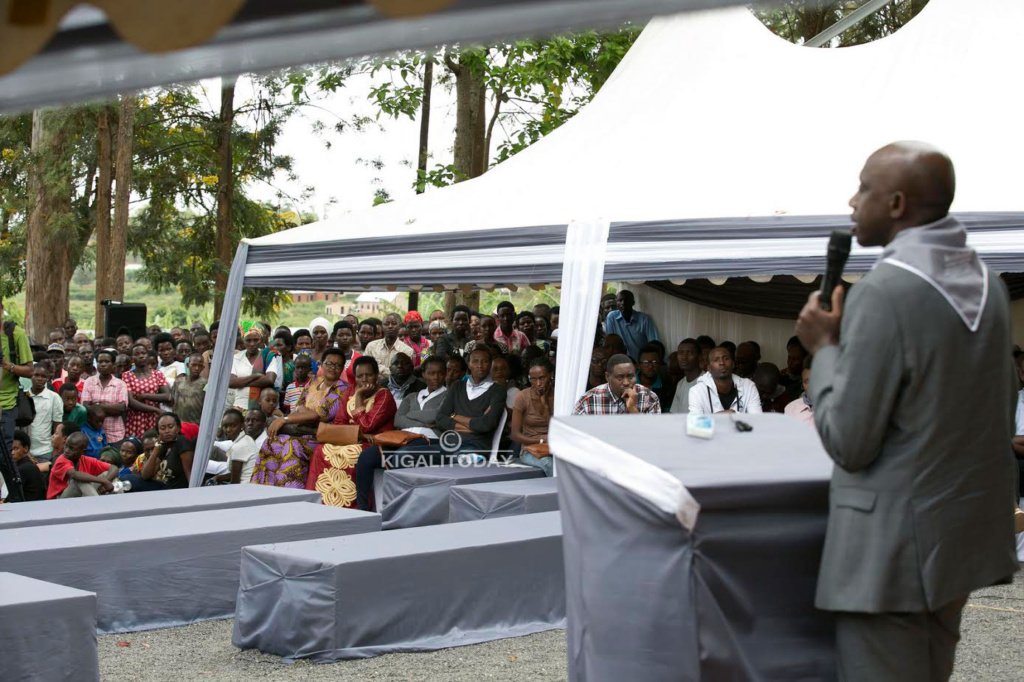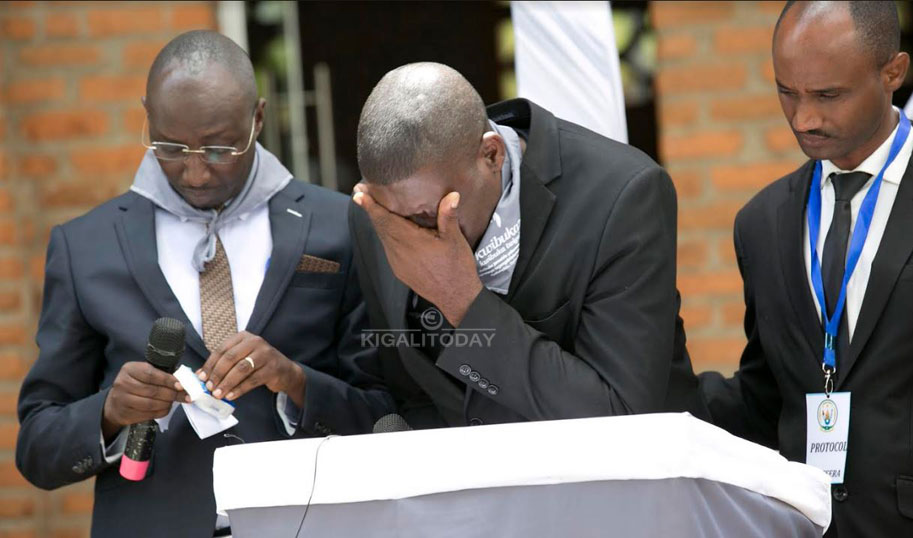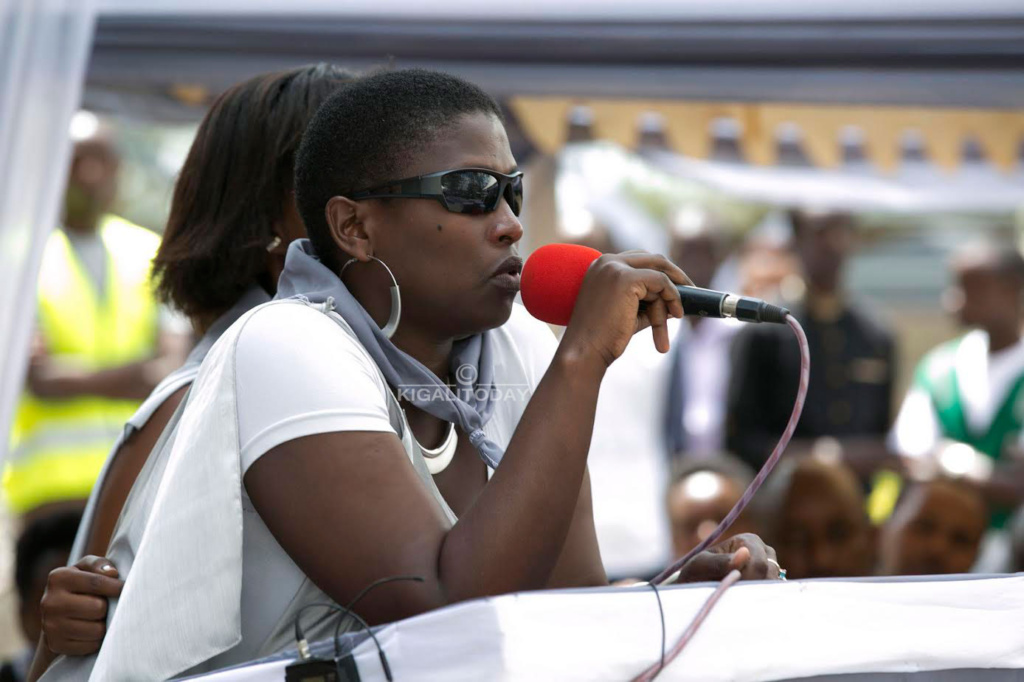
Local Government Minister, Kaboneka Francis addressing residents during commemoration event at Ntarama Genocide memorial in Bugesera district #Kwibuka23
Silas Ntamfurayishyari joined Juvenal Habyarimana’s army (Ex-FAR) in April 1990 and by 1992 he noticed that there were signs that Tutsi would be killed systematically.
Generals and Senior Officers who served in Juvenal Habyarimana’s army (Ex-FAR) denied knowledge of the 1994 genocide against Tutsi as an excuse for covering up killings conducted by Interahamwe militias they had trained.
But one of their own, Ntamfurayishyari, a soldier without a rank acted against orders of his commanders and colleagues.
The soft spoken Ntamfurayishyari in his late 30’s said he was stationed at Gako, Bugesera district where he was placed at roadblocks to stop Tutsi and hand them to killers, but he would later secretly let them go.
“Tutsis were murdered and some fled from Nyamata. Soon the planned genocide started in April 1994 and there was little chance for anyone of the targets to run away,” Ntamfurayishyari said in a trembling voice.
As a soldier he was ordered to round up Tutsi families in Ntarama, Bugesera district and the objective was to kill them all- women and children alike.
Now 23 years later Ntamfurayishyari said in a testimony at Ntarama Genocide memorial recounting how he acted humanely to assist 18 Tutsi to flee to neighbouring Burundi.
He and his friend at the church received information on a planned attack on Nyamata town. His friends asked him to cooperate in looting the homes and boarded a vehicle with another solider to implement the plan.
“I wanted to warn civilians that an attack was about to happen and so I suggested that I would first go to buy some bread in one of the stores. I managed to warn some people but almost immediately after I did more soldiers came into the town,” Ntamfurayishyari said that although the situation was very troubling he would find all ways possible to caution Tutsi of any massacre about to happen.
Ntamfurayishyari also convinced another Hutu soldier about his plan and enticed him to do likewise as Christians.
“We both agreed we should try to rescue some Tutsi civilians outside of the main part of town. Our only plan was to walk people in the dark of night to the border with Burundi,” Ntamfurayishyari said.

Silas Ntamfurayishyari(c) a former FAR soldier breaks down while recounting how he rebelled against his superiors to help Tutsi escape. #Kwibuka23 at Ntarama Genocide memorial, Bugesera District
The duo also managed to convince another Hutu soldier -Vincent Karemangingo, who conducted night patrols in the area- he accepted to help to hide more Tutsi.
“Vincent led the team and 18 Tutsi to a hideout 12 km out of town near the border where a Hutu widow lived. After days of resting they could cross safety to Burundi,” Ntamfurayishyari said as he sobbed in his eyes.
His actions (helping Tutsi to escape) soon leaked to then Chief Commanding Officer and a manhunt was on to have Ntamfurayishyari killed for acting against standing orders. He didn’t wait to be captured and instead fled to Burundi.
“I was taken into a refugee camp where most fleeing Tutsi were sheltered and I found among them those I had helped to escape,” he said as he paused to wipe his face as he regrets being part of EX-FAR army.
However, today he is national hero- recognised with ‘Protector of Friendship Pact’ – Umurinzi w’igihango.
“I cannot turn back the clock and change my story but I am happy to build a bright future, today I am proud to say that I completed my secondary school last year,” He said.
Ntarama genocide memorial is a final resting place for more than 5,000 victims; the church of Ntarama was transformed into a genocide memorial on 14th April 1995.
The number of victims includes those killed inside the church and others that were exhumed from surrounding areas.
Niwemugeni Chantal survived from the church massacre when the Interahamwe attacked the church; “They threw grenades and sprayed a spicy substance inside the Church. Thereafter Interahamwe entered with machetes and spears,” she said in an emotional testimony as tears rolled down from her eyes.
After surviving these killings at the Church, Niwemugeni and a few of her surviving relatives fled to wetlands along the river but Interahamwe pursued them.
“Some people decided to drown themselves in the river,” she said adding that her elder sister and her children died there.

Niwemugeni Chantal survived from the church massacre
In a powerful and painful testimony, Niwemugeni said, “After the Genocide, we were left hopeless. Today, unity and reconciliation programs helped us re-unite again as Rwandans,” she said thanking the RPA soldier that rescued them.
“We rebuilt our lives, caught up with our studies now, I have a Master’s degree in Finance and looking forward to pursuing a PHD,” she said with confidence.
Local Government Minister, Kaboneka Francois, the guest of honour at Ntarama commemoration event this April 9, 2017 told survivors that there is hope and new life ahead of Rwanda.
“Today, we are proud of those survivors who are, step by step, rebuilding their lives. As Rwandans deserve to live descent lives, we owe it to ourselves to strive for the better,” he added.
‘Let’s all join hands in rebuilding this nation that has lived through worse,”
He also expressed his gratitude to Ntamfurayishyari who rescued more than 18 Tutsi during the genocide.
“Many of us would have wished to have had many who followed Ntamfurayishyari’s example. They would have rescued even more people,’ he said.
Bugesera is the only district with two Genocide Memorials at national level and several others, most Memorials being churches which were transformed into slaughterhouses during the trial-Genocide in 1959 and the 1994 Genocide against the Tutsi.

